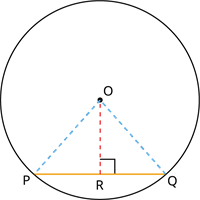PDF chapter test TRY NOW
Perpendicular from the Centre to a Chord
Illustration:
Consider a circle with centre O and a chord PQ as follows:
Draw a line OR perpendicular to the chord PQ.
Join the points OP and OQ.

Two right triangles ORP and ORQ, are obtained where \angle ORP = \angle ORQ = 90^{\circ} since OR \perp PQ.
Here, OP and OQ are radius. So, they are equal.
Also, the side OR is common to the triangle ORP and ORQ.
Therefore, by the RHS rule (In two right-angled triangles, if the length of the hypotenuse and one side of one triangle is equal to the length of the hypotenuse and corresponding side of the other triangle, then the two triangles are congruent), the triangles are congruent.
This implies that the sides PR = RQ.
Based on this congruency, the following theorems are obtained.
Theorem: The perpendicular from the centre of a circle to a chord bisects the chord.
Explanation:

The theorem states that if O is the centre and PQ is the chord, then the perpendicular OR from the centre O to the chord PQ bisects the chord PQ (i.e.) PR = RQ.
Example:
The chord of length 24 cm is drawn from a perpendicular distance of 9 cm from the centre of the circle. Find the radius of the circle.
Solution:
The pictorial representation of the given question is as follows:

Given the distance from the centre of the circle = 9 cm
The length of the chord = 24 cm.
Here, \angle ORP = 90^{\circ}.
Therefore, by the theorem, we have:
PR = RQ
=
= 12 cm
Consider the triangle OPR:
By the known Pythagoras theorem:
\text{Hypotenuse side}^{2} = \text{Adjacent side}^{2} + \text{Opposite side}^{2}
Let's find the length of OP as follows:
OP^{2} = OR^{2} + RP^{2}
= 9^{2} + 12^{2}
= 81 + 144
= 225
Thus, OP = \sqrt{225}
= 15 cm
Therefore, the radius of the circle is 15 cm.
Converse of the theorem: The line joining the centre of the circle and the midpoint of a chord is perpendicular to the chord.
Explanation:

The theorem states that if O is the centre and R is the mid-point of the chord PQ, the line joining the centre O and the mid-point R is perpendicular to the chord PQ.
Example:
Find the measure of the angle between the line joining the centre of the circle and the mid-point of the chord of the circle.
Solution:
By the theorem, the line joining the centre of the circle and the midpoint of a chord is perpendicular to the chord.
So, the line from the centre of the circle and the midpoint of a chord are perpendicular to each other.
That is, the angle between the line from the centre to the chord is 90^{\circ}.
Therefore, the measure of the angle between the line joining the centre of the circle and the mid-point of the chord of the circle is 90^{\circ}.
